In this issue:
- Director’s Corner
- GRETA Demonstrates Key Performance Parameters
- Nuclear Data Program: From Seaborg to Nuclear Structure and Beyond
- Building a STEM Workforce Pipeline
- NSD Community Agreement
- NSD Staff Gather at Offsite Retreat
- Fragments
-
Director’s Corner
February 2025
It has been a busy time for the division since the last newsletter with various research advances, awards, collaboration meetings, and other activities, some of which are featured in this issue of the NSD Newsletter.
The GRETA project has made steady progress and started to demonstrate its Key Performance Parameters (KPP), a major step towards achieving CD4-A approval for early science planned for this spring. You can find more details on the GRETA progress in this issue of the newsletter. In November we welcomed 180 scouts to the Lab for the 12th Annual Nuclear Science Day for Scouts and a number of NSD volunteers supported the event. In December, we held our 2nd annual off-site division retreat with close to 120 participants engaging over two days in broad discussions covering NSD science highlights, our collaboration across the division and across Berkeley Lab, career development strategies, outreach engagement, and culture building activities. Following outcomes from the 2023 division pulse survey and last-year’s lab-wide culture survey the division has also rolled out a Community Agreement to support ourselves and each other in building a stronger community culture in the division. You can find more context on this in this issue.
Since our last Newsletter, there were also a number of other noteworthy developments. We were able to celebrate Raúl Briceño, a faculty scientist in the Nuclear Theory Group who was among the recipients of this year’s Presidential Early Career Award for Scientists and Engineers. The Nuclear Data Group in the Low-Energy Program was elevated to a Program within the Division, recognizing its leading role in the national and international nuclear data communities, and the growth of nuclear data initiatives in basic and applied research. An example for this is the recent Physical Review Letter (PRL) by a collaboration of scientists from the Accelerator Technology & Applied Physics (ATAP) Division and NSD’s Nuclear Data Program. The paper reports on the enhancement of isomer population in bromine isotopes when exciting them using ultra-fast electron beams generated via laser-plasma acceleration at ATAP’s BELLA Center.
Other notable publications since the last newsletter include a PRL on the definition of jets in semi-inclusive deep-inelastic scattering at the future Electron Ion Collider; and an Editor’s Suggestion in Physical Review C on nuclear-level effective theory of 𝜇→𝑒 conversion. -
GRETA Demonstrates Key Performance Parameters
The Gamma-Ray Energy Tracking Array (GRETA) project is advancing quickly towards the Critical Decision 4A (CD-4A) milestone, which marks the completion of the majority of the project scope, and will be followed by delivery of the array to the Facility for Rare Isotope Beams (FRIB) this summer.
A critical step in the preparation for CD-4A is to demonstrate that all of the key performance parameters (KPPs) defined for the project, which capture the required capabilities of the system, have been achieved. These included delivery of at least 6 GRETA Quad Detector Modules, and the electronics systems to instrument fully all 30 GRETA Quad Modules which will comprise the complete array. With the support of the LBNL survey and alignment group, the project has also confirmed that the GRETA mechanical support structures can hold the load of all 30 Quad Modules with the required precision and can be aligned such that the location of all detectors is known at the level of better than 1mm.
Computing performance was also verified in January with the demonstration of the GRETA computing cluster’s capacity to perform “signal decomposition”, or the localization of gamma-ray interactions within a HPGe crystal. This computationally-expensive calculation was demonstrated at 511,000 signal decompositions per second, exceeding the specified 480,000 for which the array was designed.
Finally, the integrated systems performance was confirmed through measurement of a gamma-ray calibration source with 6 Quad Modules installed in the GRETA array at Building 88 onsite at LBNL. Pictured in Figure 1, the Quad Modules were installed in a close-packed configuration and fully instrumented with all of the GRETA electronics and support systems. The system KPP required the energy resolution to be less than 3.0 keV for the 1.33 MeV transition using a 60Co source – the project achieved a resolution of 2.39 keV, exceeding the required performance.
GRETA is a $58M project funded by the DOE Office of Nuclear Physics and led by the LBNL’s Nuclear Science Division (NSD). The project team that includes staff from NSD, ESNET, and Engineering Division at LBNL, and from Argonne National Laboratory, Oak Ridge National Laboratory and FRIB, are now preparing for the CD-4A review of the project to take place later this Spring.
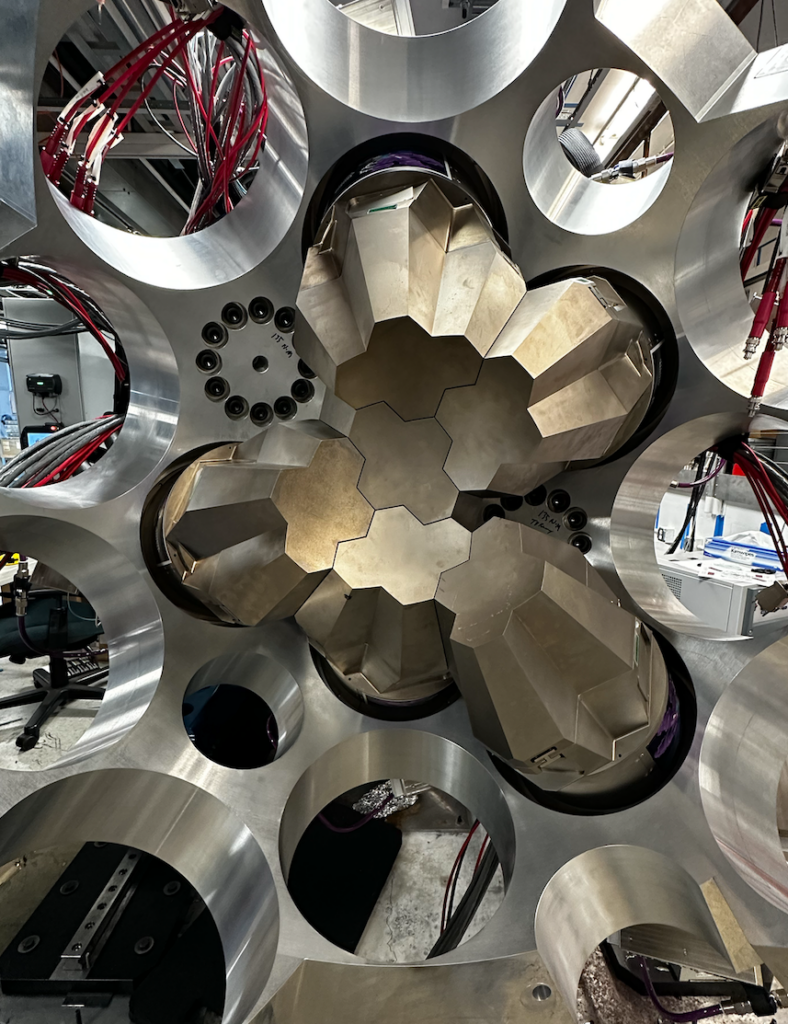
Figure 1: 6 Quad modules of GRETA installed in the first configuration for testing. -
Nuclear Data Program: From Seaborg to Nuclear Structure and Beyond
The Nuclear Data Program at Lawrence Berkeley National Laboratory (LBNL) and the University of California Berkeley (UCB) is rooted in a tradition of groundbreaking research, tracing its origins to the pioneering discoveries of isotopes by Glenn T. Seaborg and his team. This includes technetium-99m, which remains sought after in modern nuclear medicine with millions of diagnostic procedures performed annually worldwide. During the first 50 years, the nuclear data efforts were primarily focused on decay and neutron capture data, forming a cornerstone of nuclear science.
Over the last decade, the program has diversified and expanded into actively addressing nuclear data needs for applied areas such as plasma nuclear science, isotope production for space and medical applications, and nuclear energy innovations from fusion to advanced fission systems as well as the fundamental nuclear and astrophysical sciences. Recent highlights include results on isomer populations using laser driven electron beams [1] and providing new and improved nuclear data critical for molten salt chloride reactors, key to next-generation nuclear energy systems [2].
Today, the program’s activities are broader than ever, addressing pressing needs in nonproliferation, national security, and nuclear science applications. For instance, LBNL and UCB researchers are advancing data collection in the nuclear quasicontinuum and refining models to support nuclear-plasma interactions and energy production.
Looking forward, the Nuclear Data Program aims to continue its efforts aligned with the national plan to meet nuclear data needs across basic sciences and applications. This includes a commitment to train the next generation of scientists and engineers, ensuring sustained innovation and expertise. By integrating cutting-edge methodologies with domestic and global collaborations, the program is poised to maintain its leadership in shaping the future of nuclear data efforts.
For more information, visit LBNL’s Nuclear Data and UCB’s Nuclear Data Program .
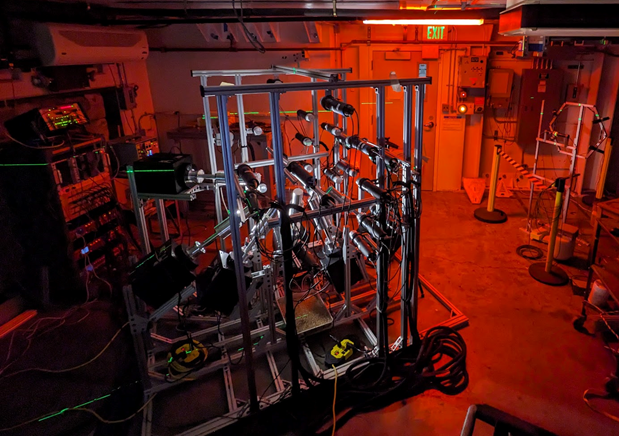
Figure 1: The GENESIS detector array at LBNL which is used by the Nuclear Data Program to measure neutron induced nuclear data. -
Building a STEM Workforce Pipeline
On November 9, 2024, NSD hosted the 12th annual Nuclear Science Day for Scouts Event. One hundred and eighty scouts and fifty leaders attended this year’s event. Since the inception of this annual event in 2011, it has attracted over two thousand youths and five hundred scout leaders to Berkeley Lab. The primary goal of these events is to introduce nuclear science to middle- and high-school-aged students as a career option in their future.
The day began with a short lecture by NSD scientistHeather Crawford on the “ABC” ‒ representing alpha, beta, and gamma decay ‒ of nuclear science. Jacklyn Gates, the group leader of NSD’s Heavy Element program, then presented how to synthesize and identify Element-120 using a titanium-50 beam in an accelerator facility such as the 88-Inch Cyclotron.
After these two lectures, our guests performed hands-on activities at stations around the Berkeley Lab campus. These activities included the use of Geiger counters to survey everyday items (such as tableware) for radioactivity, the use of a portable cosmic-ray detector to “see” cosmic muons, the construction of a simple electroscope to get a deeper understanding of ionizing radiation, and assembly of different nuclei with marshmallows and chocolate. The groups also toured the beamlines of the Advanced Light Source, and had the opportunity to discuss career paths with scientists trained in nuclear science.
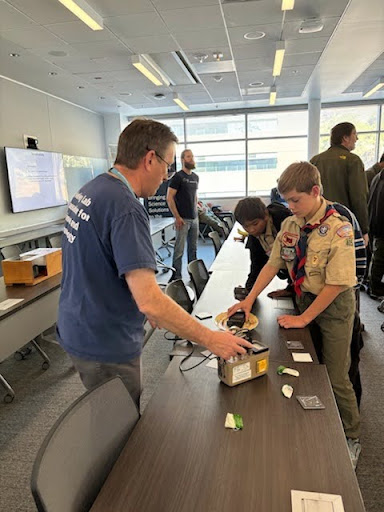
Figure 1: Head of the 88-Inch Cyclotron program Larry Phair is helping a scout to survey radioactivity with a Geiger counter. In addition to NSD, Berkeley Lab’s K-12 STEM Education and Outreach Office and the Advanced Light Source supported this year’s event. Forty-seven volunteers from NSD and across the Lab helped conduct activities at the event.
Staff in NSD also participate in other events to induce a sense of wonder in school-age kids and encourage them to pursue a STEM career. In December, Hannah Parrilla of the Applied Nuclear Physics program presented her research in a poster to students (in a style typical for school science fairs) at the Reverse Science Fair at Martin Luther King Jr. Middle School in Berkeley, an event coordinated by Berkeley Lab’s K-12 STEM Education and Outreach Office and Community Resources for Science in Berkeley. We will continue to engage these partners to promote nuclear science to the local community.
Figure 2: Hannah Parilla presenting her research to students at Martin Luther King Jr. Middle School, Berkeley CA -
NSD Community Agreement
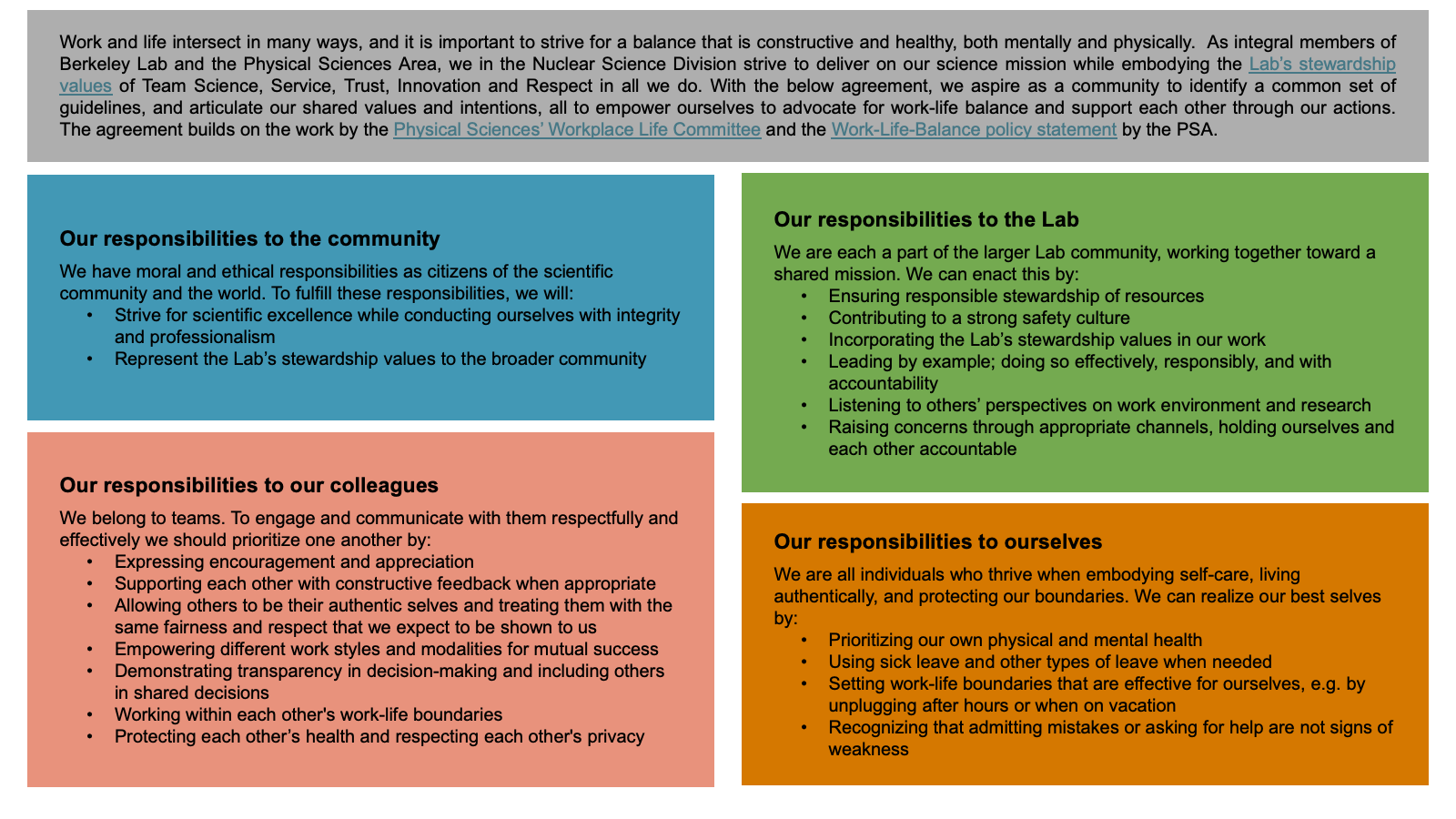
In October 2023 the Nuclear Science Division conducted a Mentimeter Survey of NSD staff to take the pulse of the division and to identify areas where the division needed to improve its workplace culture. A number of main themes emerged from the survey results and the follow-up discussions at the NSD retreat in fall of 2023. These themes included high workload, challenges around work-life-balance, as well as lack of transparency in decision making and the need to hold ourselves and others accountable in a more consistent way. These topics were reinforced with the results of the 2024 LBNL Culture Survey. The topic of work-life-balance was also addressed by the Physical Sciences’ Workplace Life Committee which developed, jointly with the Physical Sciences Area (PSA) ALD, Natalie Roe, a Work-Life-Balance policy statement for the PSA.
Inspired by these efforts as well as the LBNL Molecular Foundry’s Community Agreement on Work Life Balance, the NSD Community Stewardship Committee (CSC) led the effort to develop a Community Agreement to identify a more specific set of guidelines with the additional aim to clearly articulate our shared values and intentions, all to empower each other to advocate for work-life balance and support each other through our actions. A draft of the agreement was presented at a NSD Staff Meeting and distributed broadly to the division, inviting feedback via a Google form. The feedback was considered by the NSD CSC and led to a refined final version of the agreement that was rolled out in December 2024.
The agreement is anchored in the recognition that work and life intersect in many ways, and it is important to strive for a balance that is constructive and healthy, both mentally and physically. It recognizes that everyone in the Nuclear Science Division is key to delivering on our science mission and underlines how important it is that our actions consistently embody the Lab’s stewardship values of Team Science, Service, Trust, Innovation and Respect in all we do.
We chose a nested approach for the agreement, providing examples for how we can fulfill our responsibilities to ourselves, our colleagues and team members, the Lab overall, as well as the community at large. The overarching intent is empowering each other to live our shared values, to advocate for work-life balance, and to support each other through our actions.
Below the main elements of NSD Community Agreement are reproduced:
Our responsibilities to the community
We have moral and ethical responsibilities as citizens of the scientific community and the world. To fulfill these responsibilities, we will:
- Strive for scientific excellence while conducting ourselves with integrity and professionalism
- Represent the Lab’s stewardship values to the broader community
Our responsibilities to the Lab
We are each a part of the larger Lab community, working together toward a shared mission. We can enact this by:
- Ensuring responsible stewardship of resources
- Contributing to a strong safety culture
- Incorporating the Lab’s stewardship values in our work
- Leading by example; doing so effectively, responsibly, and with accountability
- Listening to others’ perspectives on work environment and research
- Raising concerns through appropriate channels, holding ourselves and each other accountable
Our responsibilities to our colleagues
We belong to teams. To engage and communicate with them respectfully and effectively we should prioritize one another by:
- Expressing encouragement and appreciation
- Supporting each other with constructive feedback when appropriate
- Allowing others to be their authentic selves and treating them with the same fairness and respect that we expect to be shown to us
- Empowering different work styles and modalities for mutual success
- Demonstrating transparency in decision-making and including others in shared decisions
- Working within each other’s work-life boundaries
- Protecting each other’s health and respecting each other’s privacy
Our responsibilities to ourselves
We are all individuals who thrive when embodying self-care, living authentically, and protecting our boundaries. We can realize our best selves by:
- Prioritizing our own physical and mental health
- Using sick leave and other types of leave when needed
- Setting work-life boundaries that are effective for ourselves, e.g. by unplugging after hours or when on vacation
- Recognizing that admitting mistakes or asking for help are not signs of weakness
-
NSD Staff Gather at Offsite Retreat
In December, NSD held the second annual offsite retreat during which the whole division came together to hear updates from the scientific programs, and discuss topics including career development, outreach and communication, and cross-divisional collaboration.
The agenda included discussion of new opportunities in instrumentation and AI/ML, career development exercises, and team building activities. There was also a social hour and a poster session that showcased the research currently being conducted through NSD LDRD projects. The retreat was organized by a committee composed of staff from across the division.
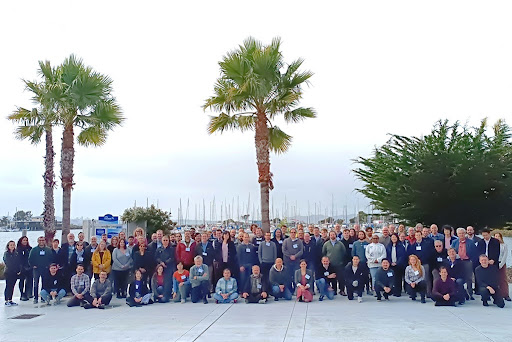
NSD Staff Retreat, November 2024 – group photo, day 2 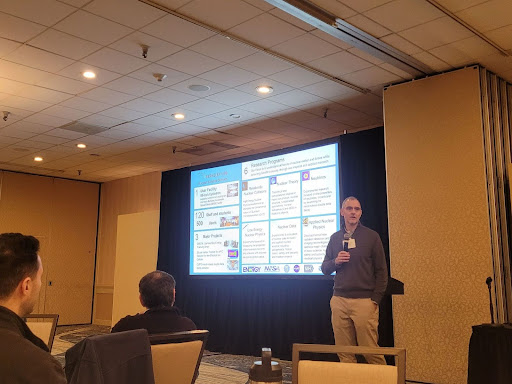
NSD Director Reiner Kruecken during slide presentation 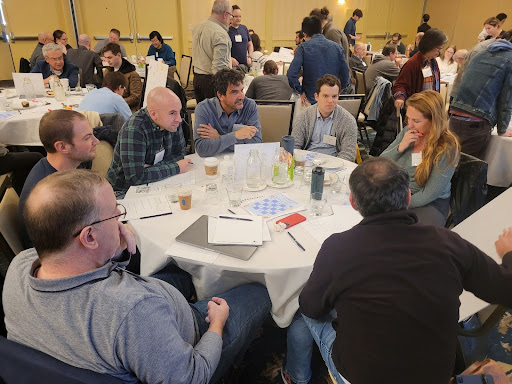
NSD Staff at workshop tables collaborating on a group activity -
Fragments
Raúl Briceño, a faculty scientist in the Nuclear Theory Program received a Presidential Early Career Award for Scientists and Engineers (PECASE), the highest honor bestowed by the U.S. government on outstanding scientists and engineers early in their careers. Further details can be found in this article.
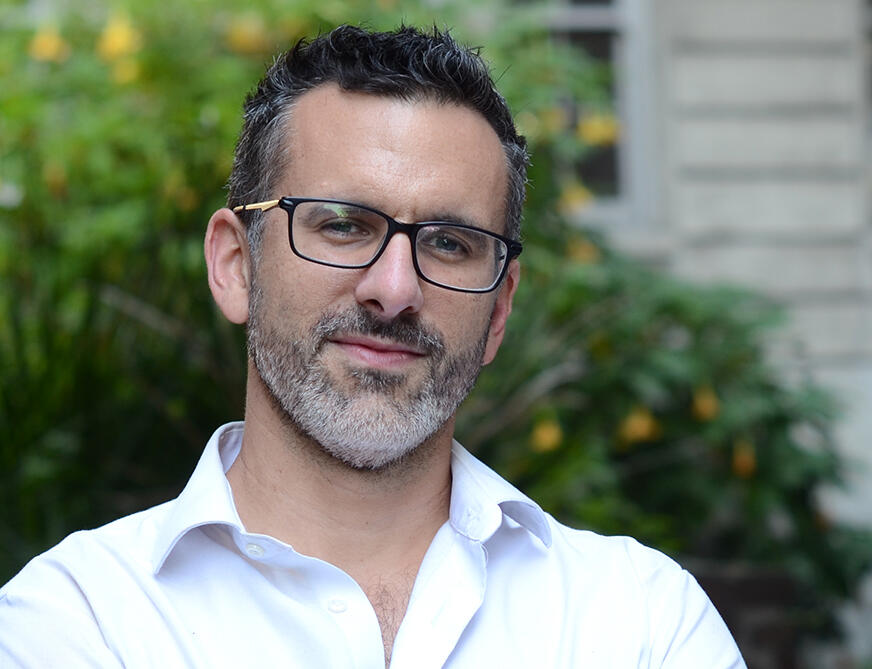
Andre Walker Loud, a Staff Scientist who is also with the Nuclear Theory Program received an Innovative and Novel Computational Impact on Theory and Experiment (INCITE) award. The award will provide Andre with 750,000 node hours per year for two years at the Oak Ridge Leadership Computing Facility (OLCF).
Several members of the Applied Nuclear Physics Program attended the 2024 IEEE Nuclear Science Symposium and Medical Imaging Conference (IEEE NSS/MIC) in Tampa in November where they presented several talks and posters, and chaired technical sessions.
NSD welcomes new hires David Matters (Scientific Engineer, Nuclear Data Program), Simeon Modre (Research Assistant, 88” Cyclotron), Michael Armstrong (Postdoctoral Researcher, Low Energy Nuclear Physics Program), Jilian Kahlbow (Staff Scientist, Low Energy Nuclear Physics Program), Miles Chen (Scientific Engineering Associate, 88” Cyclotron), Provaka Datta (Postdoctoral Researcher, Relativistic Nuclear Collisions Program), Gabriel Garcia Jimenez (Postdoctoral Researcher, Low Energy Nuclear Physics Program), Jessica Rehak (Sr. Scientific Engineering Associate, Low Energy Nuclear Physics Program), and Victor Watson (Sr. Scientific Engineering Associate, Low Energy Nuclear Physics Program).
-
Sign up for our newsletter!